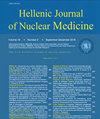Role of 18F-DCFPyL PET/CT in patients with suspected prostate cancer.
IF 0.9
4区 医学
Q4 RADIOLOGY, NUCLEAR MEDICINE & MEDICAL IMAGING
引用次数: 1
Abstract
OBJECTIVE Fluorine-18-2-(3-{1-carboxy-5-[(6-18F-flfluoro-pyridine-3-carbonyl)-amino]-pentyl}-ureido)-pentanedioic acid (18F-DCFPyL), a novel positron emission tomography/computed tomography (PET/CT) radiotracer that binds to the prostate specific membrane antigen (PSMA), is increasingly used for biochemically recurrent prostate cancer diagnostics. However, the 18F-DCFPyL characteristics of suspected prostate cancer (SPCa) have been even more rarely described. Herein, in this retrospective study, we describe the clinical impact of 18F-DCFPyL PET/CT imaging in SPCa. SUBJECTS AND METHODS We retrospectively evaluated the data of 56 SPCa patients who had undergone 18F-DCFPyL PET/CT studies. These patients were done for primary diagnosis/staging. Positron emission tomography/CT images were analyzed both qualitatively and quantitatively (maximum standardized uptake value (SUVmax) and maximum SUV normalized by lean body mass (SULmax)). Histopathologic diagnosis was taken as reference standard. The optimal cut-off of 18F-DCFPyL was determined using receiver operating characteristic curve (ROC). RESULTS All the patients were confirmed by histopathological examination via prostatectomy or prostate biopsy. Fluorine-18-DCFPyL PET/CT showed higher radiotracer uptake in prostate cancer than that in non-prostate cancer. When SUVmax 5.0 and SULmax 4.0 were cut-off points for determining prostate cancer, the sensitivity of 18F-DCFPyL was 90%, specificity was 100%, and accuracy was 91.2%. Furthermore, there were highly significant positive correlations between SUVmax, SULmax and serum PSA. On comparison of areas under the curve, no significant difference was seen between SUVmax and SULmax in the sensitivity and specificity of 18F-DCFPyL PET/CT for PCa identification. However, delayed PET/CT did not improved accuracy in the term of uncertain PCa in the initial standard imaging. As for lymph node staging, the negative predictive value of 18F-DCFPyL PET/CT was 100%. CONCLUSION Fluorine-18-DCFPyL PET/CT is a promising imaging modality for initial diagnosis and preoperative N staging in SPCa.18F-DCFPyL PET/CT在疑似前列腺癌患者中的作用
目的氟-18-(3-{1-羧基-5-[(6-18F-氟-吡啶-3-羰基)-氨基]-戊基}-脲基)-戊二酸(18F-DCFPyL)是一种新型的正电子发射断层扫描/计算机断层扫描(PET/CT)放射性示踪剂,与前列腺特异性膜抗原(PSMA)结合,越来越多地用于生化复发性前列腺癌症诊断。然而,对疑似癌症(SPCa)的18F-DCFPyL特征的描述更为罕见。在此,在这项回顾性研究中,我们描述了18F-DCFPyL PET/CT成像对SPCa的临床影响。受试者和方法我们回顾性评估了56名接受18F-DCFPyL PET-CT研究的SPCa患者的数据。对这些患者进行初步诊断/分期。对正电子发射断层扫描/CT图像进行定性和定量分析(最大标准化摄取值(SUVmax)和通过瘦体重标准化的最大SUV(SULmax))。以组织病理学诊断为参考标准。采用受试者操作特征曲线(ROC)确定18F-DCFPyL的最佳切除率。结果所有患者均通过前列腺切除术或前列腺活检进行组织病理学检查。氟18-DCFPyL PET/CT在前列腺癌症中的放射性示踪剂摄取高于非前列腺癌症。以SUVmax 5.0和SULmax 4.0为检测前列腺癌症的分界点时,18F-DCFPyL的敏感性为90%,特异性为100%,准确率为91.2%,SUVmax、SULmax与血清PSA呈高度显著正相关。在曲线下面积的比较中,SUVmax和SULmax在18F-DCFPyL PET/CT用于PCa鉴定的敏感性和特异性方面没有显著差异。然而,在最初的标准成像中,延迟的PET/CT并没有提高PCa不确定的准确性。在淋巴结分期方面,18F-DCFPyLPET/CT的阴性预测值为100%。结论氟-18 DCFPyLDPET/CT是一种很有前途的SPCa早期诊断和术前N分期的影像学方法。
本文章由计算机程序翻译,如有差异,请以英文原文为准。
求助全文
约1分钟内获得全文
求助全文
来源期刊
CiteScore
1.40
自引率
6.70%
发文量
34
审稿时长
>12 weeks
期刊介绍:
The Hellenic Journal of Nuclear Medicine published by the Hellenic Society of
Nuclear Medicine in Thessaloniki, aims to contribute to research, to education and
cover the scientific and professional interests of physicians, in the field of nuclear
medicine and in medicine in general. The journal may publish papers of nuclear
medicine and also papers that refer to related subjects as dosimetry, computer science,
targeting of gene expression, radioimmunoassay, radiation protection, biology, cell
trafficking, related historical brief reviews and other related subjects. Original papers
are preferred. The journal may after special agreement publish supplements covering
important subjects, dully reviewed and subscripted separately.

 求助内容:
求助内容: 应助结果提醒方式:
应助结果提醒方式:


